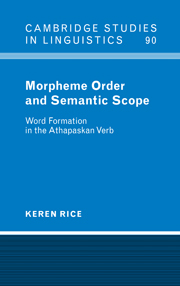Book contents
- Frontmatter
- Contents
- Preface
- 1 Introduction: Beginning the Journey
- PART I FIRST STEPS
- 2 Introducing the Problem
- 3 Global Uniformity and Local Variability: A Possible Account
- PART II THE LEXICAL ITEMS
- PART III THE FUNCTIONAL ITEMS
- PART IV A VIEW OF THE LEXICON
- PART V THE END OF THE JOURNEY
- PART VI APPENDIXES
- Notes
- References
- Name Index
- Languages Index
- Subject Index
2 - Introducing the Problem
Published online by Cambridge University Press: 06 July 2010
- Frontmatter
- Contents
- Preface
- 1 Introduction: Beginning the Journey
- PART I FIRST STEPS
- 2 Introducing the Problem
- 3 Global Uniformity and Local Variability: A Possible Account
- PART II THE LEXICAL ITEMS
- PART III THE FUNCTIONAL ITEMS
- PART IV A VIEW OF THE LEXICON
- PART V THE END OF THE JOURNEY
- PART VI APPENDIXES
- Notes
- References
- Name Index
- Languages Index
- Subject Index
Summary
Athapaskan languages have verbs that are extraordinarily complex, and that pose a challenge to theories of morphosyntactic structure (see, for example, Aronoff 1994, Hargus 1988, Rice 1993, 1998, Speas 1984, 1987, 1990, 1991a,b, Spencer 1991, Travis 1992, for discussion). The verb word is complex in many ways: it is morphologically rich, the surface ordering of morphemes is apparently without reason, discontinuous dependencies are frequent, and blocking effects between morphemes of identical shape but different meaning are abundant.
The goal of this chapter is to outline the structure of an Athapaskan verb as traditionally described and to examine the claim that a template is required to define the ordering of morphemes within the verb.
The Templatic Nature of the Athapaskan Verb
As discussed in chapter 1, the verb in Athapaskan languages is typically described as consisting of a template, or string of fixed order positional classes. The template orders the morphemes, and each morpheme is marked lexically for the position in the template that it occurs in. In addition, phonological boundary types are lexically associated with the different morphemes in order to account for their phonological properties.
A template for Slave ([slevi]), adapted from Rice 1989, is given in (1). See appendix 1 for a list of templates proposed in the literature for a number of languages of the family. Terminology will be clarified throughout the book; I do not attempt to define terms here.
- Type
- Chapter
- Information
- Morpheme Order and Semantic ScopeWord Formation in the Athapaskan Verb, pp. 9 - 19Publisher: Cambridge University PressPrint publication year: 2000

